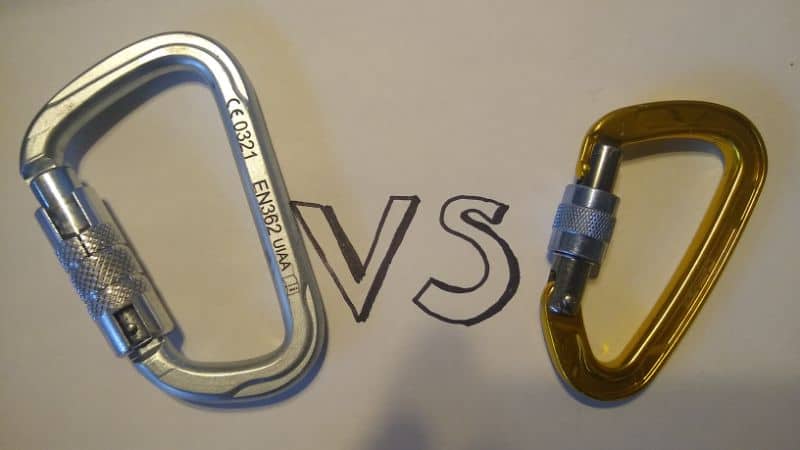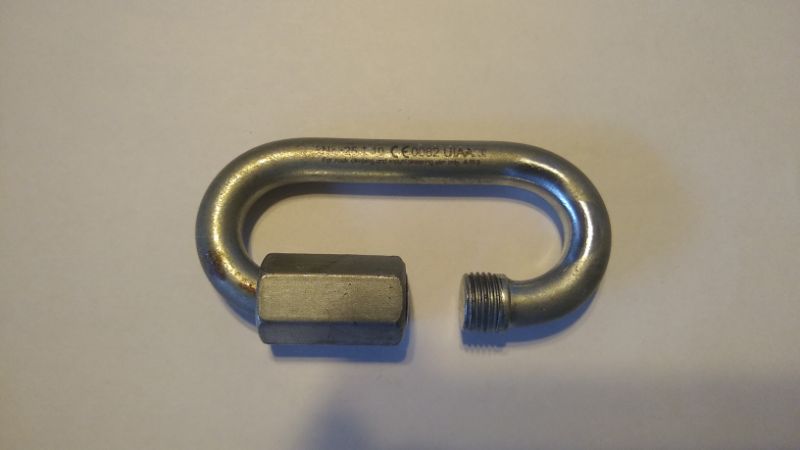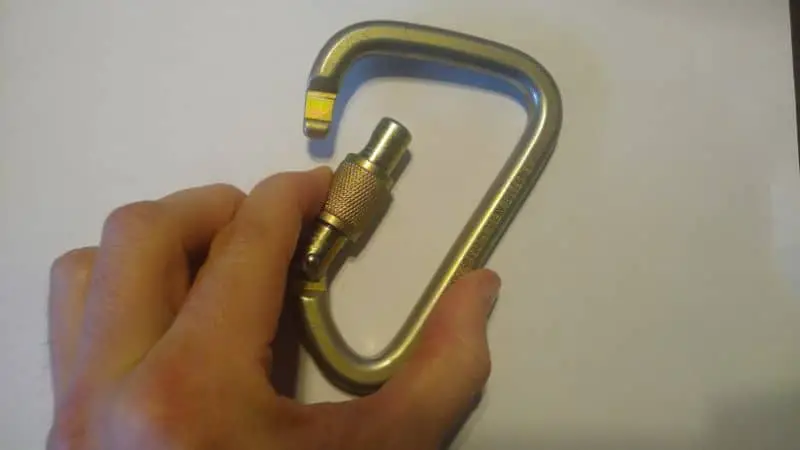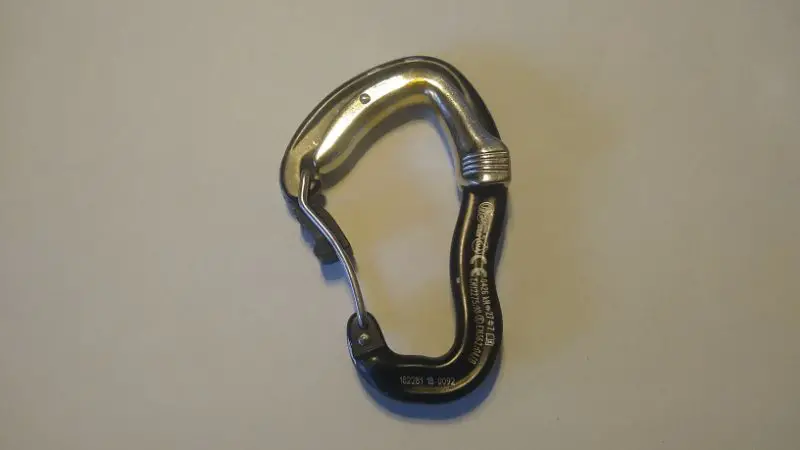As you probably know, aluminum is the name of the climbing game. It’s strong, lightweight, corrosion-resistant – and did I mention lightweight? Aluminum is roughly ⅓ the weight of steel, so when you’re lugging that 20-lb rack of trad gear up a wall, be thankful it isn’t 60 lbs!
But steel still has its place in the climbing repertoire. Over the years, I’ve added a handful of steel carabiners to my trad rack. I’d like to introduce them to you and consider the question, “What are the benefits of steel vs aluminum carabiners?”

Smackdown: Steel Vs Aluminum Carabiners – Pros & Cons
Before I show you some of my favorites, let’s consider the advantages and disadvantages of steel and aluminum carabiners.
Advantages of Steel Climbing Carabiners
1. Stronger
For the same size, steel carabiners are usually quite a bit stronger than aluminum. I have steel carabiners rated at 35, 45, and even 50 kN!
There are a lot of misconceptions about Minimum Breaking Strength (MBS). These standards are set by ASTM Standard F1774. This standard calls for an MBS of 20kN on the long axis, and 7kN on the short axis (when crossloaded). I’ll talk about these misconceptions later in this post.
With that said, I caution you not to fetishize strength. Don’t pursue kN ratings for their own sake. Both steel and aluminum carabiners are more than strong enough for their intended uses; that’s why we have standards and certifications!
2. More Durable
Steel is harder and denser than aluminum. It’s more resistant to abrasion, so it won’t groove or notch as quickly as aluminum. This is why most of the permanent rigging in a climbing gym is made of steel, as aluminum rigging would quickly wear down with commercial use.
3. Less Grooving
This is the opposite side of the same coin as “more durable.” Because steel doesn’t wear away as fast as aluminum, you keep that nasty metal oxide dust out of your rope and off your hands! This is critical in sandy environments, where a sandy rope can wear through aluminum in a matter of hours.
Disadvantages of Steel Climbing Carabiners
1. Heavier
Steel is roughly 3 times as heavy as aluminum. You might not notice the difference with one or two carabiners, but in a trad, aid, or alpine climb, you’ll be thanking your lucky stars for the ingenious engineers who figured out how to use aluminum to make carabiners!
2. Fewer Designs
Most steel carabiners are made for the fire, rescue, and industrial markets. They tend to be supersized locking carabiners with large gates made of fat round stock. Not a great choice if you’re looking for a small wire-gate ‘biner.
Where Would You Use a Steel Climbing Carabiner?
Top Rope
If you top rope often, I highly recommend investing in a steel carabiner! Steel does not abrade like aluminum. You’ll get years, even decades of life out of a steel ‘biner, and even better, you’ll keep that nasty aluminum oxide dust out of your rope. I use a pre-rigged Sliding X with steel Maillon as my go-to top rope rigging at a 2-point bolted anchor.
Fixed Hardware
Steel is commonly used for fixed hardware installations: climbing bolts, hangers, anchor chains, clevis hooks, rappel rings, etc. Gym owners choose steel for the wear durability; outdoor route-setters choose steel for the weather-resistance.
We won’t dive into rescue rigging in this post, but most multidirectional pieces of equipment, like D-shaped quick links, triangular Delta links, and are almost made out of alloy steel.
Anchor Masterpoint
Some anchors can be rigged with an HMS carabiner as the master point. Steel is the ideal material since softer aluminum carabiners won’t notch or scratch it.
Belay Carabiner
Steel carabiners have a unique role in self-belay systems. When lead rope soloing, for instance, your primary and secondary devices (or knots) should be backed up with steel locking carabiners.
Rappel Carabiner
Since many recreational rock climbers rappel with a tube-style belay/rappel device, the rope rubs against the carabiner. I’ve seen carabiners lose 10% of their material in a single long afternoon in a sandy canyon! Most other vertical sport athletes use descenders designed to eliminate rope-on-carabiner friction, but in rock climbing, it’s still quite common.
Examples of Rock Climbing Steel Carabiners
Let me introduce you to a handful of my climbing carabiners.

This is a Metolius 10mm steel quick link, rated for 25 kN/10 kN. Great for a self-belay carabiner if I’m worried about cross-loading, where it’s significantly stronger than most carabiners rated 7-8 kN.

This is a Mad Rock XL carabiner, rated for 50 Kn/ 8kN. Honestly, it’s my least favorite steel carabiner. It’s so huge! This is what I use as a carabiner master point, but I wish I had bought a pear-shaped HMS rather than the offset D shape.

This is a Grandwall Zion steel carabiner rather than 35 kN/9 kN. It has a tri-act locking mechanism rather than a simple screwgate. This would be the perfect general-purpose belay/rappel carabiner … if only I had ordered a size smaller!

Bonus question: Is this a steel carabiner? No, it’s not! But it has some interesting similarities. It’s the Kong Ergo, and it’s actually marketed for commercial uses like adventure parks. It has an aluminum body but a lever wear bar made of marine bronze, which is much more durable than aluminum bar stock. It’s like a poor man’s version of the Elderid Bulletproof, which uses a stainless steel insert. But I love it – it’s the easiest self-locking gate I’ve ever used!
What Alloy Are Steel Carabiners Made Of?
It is a common misconception that all climbing steel carabiners are made from 300-series stainless steel alloys like 316, which is the standard for marine-grade stainless steel. But that’s not true, and here’s a clue: If you see that the carabiner was heat-treated to improve strength, you know it isn’t 300-grade stainless steel.
Instead, many steel carabiners are made of high-strength alloy steel protected by a white zinc or gold chromate coating. These are common in fire, rescue, and industrial applications and are certified to NFPA 1983.
Stainless steel isn’t the best choice for all applications, so don’t turn up your nose at alloy steel. I use an alloy steel locking oval carabiner as a self-belay carabiner, and I feel much better with the 35 kN rating!
What Alloy Are Aluminum Carabiners Made Of?
Most aluminum carabiners are made from 7075-T6, an aircraft-grade aluminum alloy. 7075 describes the grade and T6 describes the heat treatment process.
Are Steel Carabiners Stronger Than Aluminum Carabiners?
Let’s rephrase the question. In casual conversation, we may use “strength” and “toughness” interchangeably, but to engineers, these are different physical properties.
In fact, engineers split strength into yield strength, where the material permanently deforms, and ultimate strength, where the material fractures. Toughness is essentially the difference between the two under impact. In layman’s terms, a tough material will bend or deform but not break.
UIAA safety standards test carabiners to their breaking point and demand a static ultimate strength of greater than 20 kN. Here’s how the test works: A carabiner is clamped in an Instron Tensile Test Machine and slowly pulled until it fractures (which may or may not be at the ultimate strength).
The test is repeated three times for three different configurations corresponding to the three kN ratings stamped on every climbing carabiner:
- Static resistance on the longitudinal axis with the gate closed
- Static resistance on the longitudinal axis with the gate open
- Static resistance on the transversal axis
If you’re wondering why carabiners are tested statically instead of dynamically, the UIAA has an answer for that. Dynamic testing is more likely to cause failure from gate flutter than material fracture, they argue, and slow “static forces are worse than dynamic ones: pulling with the same force for many seconds is worse than for a few tenths of a second.”
So it’s important to realize that both steel and aluminum climbing carabiners are tested to their breaking point. Some people mistakenly believe steel carabiners automatically have a greater margin of safety because of their toughness, but that’s not a deciding factor in the testing standard. Trust the rating on the carabiner; don’t add your own imaginary margin.
However, the UIAA standard does not test for shock absorption or hysteresis effects. Generally, alloy steels have greater shock absorption than heat-treated aluminum – but I’ll stop here! As a mechanical engineer myself, it’s easy to get lost in these weeds. Eventually, these distinctions become pedantic. All certified carabiners are safe when used for their intended purpose.
I’ll leave you with a video link to a fun YouTube Channel, HowNot2, where they often break-test climbing and slacklining gear. Here’s a video of break testing aluminum and steel quick links for slacklining:
